Introduction
As technology has made it easier for workers to collaborate across different time zones and locations, managing schedules has become more complicated. As a result, businesses have needed to employ new strategies and tools to become efficient in how tasks are scheduled.
Team calendars have become essential to the growth of businesses as they help teams view and manage important dates, deadlines, and events. In this article, we discuss the definition of a team calendar, the advantages of using one, how to select the best team calendar for your business, and the five best team calendars available on the market today.
What is a team calendar?
A team calendar is a shared calendar that allows members of a team to view, schedule, and coordinate their work activities and schedules. It ensures that every team member is aware of important dates and schedules.
Team calendars, as a productivity tool, help businesses track project milestones and deadlines, and manage work schedules. They help to improve transparency and accountability within the team, as everyone can see what their colleagues are working on and when they are available.
However, team calendars do more than help workmates track work. More importantly, they help businesses save millions of dollars. Every week, companies waste up to $1.85 billion on scheduling and rescheduling calls.
Advantages of using a team calendar
There are several advantages of using a team calendar:
1. Improved coordination and scheduling
One of the key advantages of using team calendars is that it increases agility by improving team coordination and scheduling. It enables team members to view each other's schedules and availability, making it easier to plan meetings, deadlines, and project milestones.
This drastically reduces miscommunication, saves time, and ensures deadlines are met, helping save millions of dollars. This advantage is applicable to both remote teams and onsite workers.
2. Better transparency
Team calendars promote transparency across the entire company by allowing team members to see what their colleagues are working on and when. At any given time, business owners can check who's working on what and when team projects are to be delivered.
This makes it easier to align goals, delegate tasks, and share resources, leading to better collaboration and teamwork. Transparency also promotes accountability, as team members can see what their colleagues are doing and hold each other responsible for meeting deadlines and delivering quality work.
3. Better time management
Team calendars can help team members manage their time more effectively by reducing the risk of double-booking and conflicting priorities. When team members can see each other's schedules, they can plan their work around their colleagues' availability, reducing downtime and maximizing productivity. Additionally, team calendars can help team members prioritize their tasks, making it easier to focus on high-priority work and avoid distractions.
4. Enhanced collaboration
Team calendars facilitate collaboration by making it easier for team members to share information, resources, and deadlines. As multiple employees and teams are often involved during the lifecycle of a project, it's important that there’s a single point of contact that clearly shows who’s responsible for what, what timeframe to work with, and who to handover to.
This leads to better communication, teamwork, and knowledge sharing, all of which improves team performance and results. When team members work together more effectively, they can achieve more significant outcomes, build stronger relationships, and foster a culture of collaboration and innovation.
5. Improved productivity
Team calendars improve a team’s productivity by providing a centralized tool for managing schedules, deadlines, and tasks. This eliminates the need for multiple communication channels and reduces the risk of errors and miscommunication. With a team calendar, team members can focus on their work without worrying about scheduling conflicts, missed deadlines, or miscommunication, leading to greater productivity and better results.
In conclusion, scheduling tools such as team calendar software help entire teams streamline their workflow, promote teamwork and communication, and achieve better outcomes.
How to choose the best team calendar
Here are the five features you need to look out for before selecting a team calendar:
1. Features
The best collaborative calendars should have a wide range of features that cater to the needs of your team. Some key features you should look for before selecting a team calendar include the ability to manage multiple calendars, schedule meetings, and integrate with other apps and services. Other features to consider include the ability to set reminders, task management, share files and notes, and customize calendars to fit the preferences of individual team members.
2. Accessibility
Accessibility is another critical factor to consider when choosing the best team calendar. The calendar should be easily accessible to all team members, regardless of their location or device.
A cloud-based team calendar is ideal as it allows team members to access it from anywhere with an internet connection. The calendar should also be compatible with a range of devices, including desktop computers, laptops, tablets, and smartphones. This ensures that all team members can access and update the calendar on the go, no matter where they are.
3. Security
Security is a critical consideration when selecting a team calendar. The calendar should have robust security features to protect sensitive information from unauthorized access, including encryption and multi-factor authentication. Additionally, the calendar should allow for different access levels, ensuring that only authorized team members can view and edit specific events or calendars.
4. User-friendliness
The best team calendar should be easy to use, even for team members who aren't tech-savvy. It should have a user-friendly interface that's intuitive and easy to navigate. Calendars should also be customizable, allowing team members to personalize the calendar to fit their preferences. It should have a simple and straightforward process for creating and scheduling events, deadlines, and tasks, as well as for assigning them to specific team members.
5. Cost
Another vital factor to consider when selecting the best option for your team is the cost of the team calendar. Some team calendars are free, while others require a monthly/yearly subscription. It's important to balance the cost of each calendar with your team's budget, key features, accessibility, security, and user-friendliness of the calendar.
By selecting a team calendar that meets these criteria, you can ensure that your team works more efficiently, leading to better results and outcomes.
The 5 best team calendars of 2023
Here’s a list of the five best team calendars of 2023
1. Motion - Best for multiple calendar management
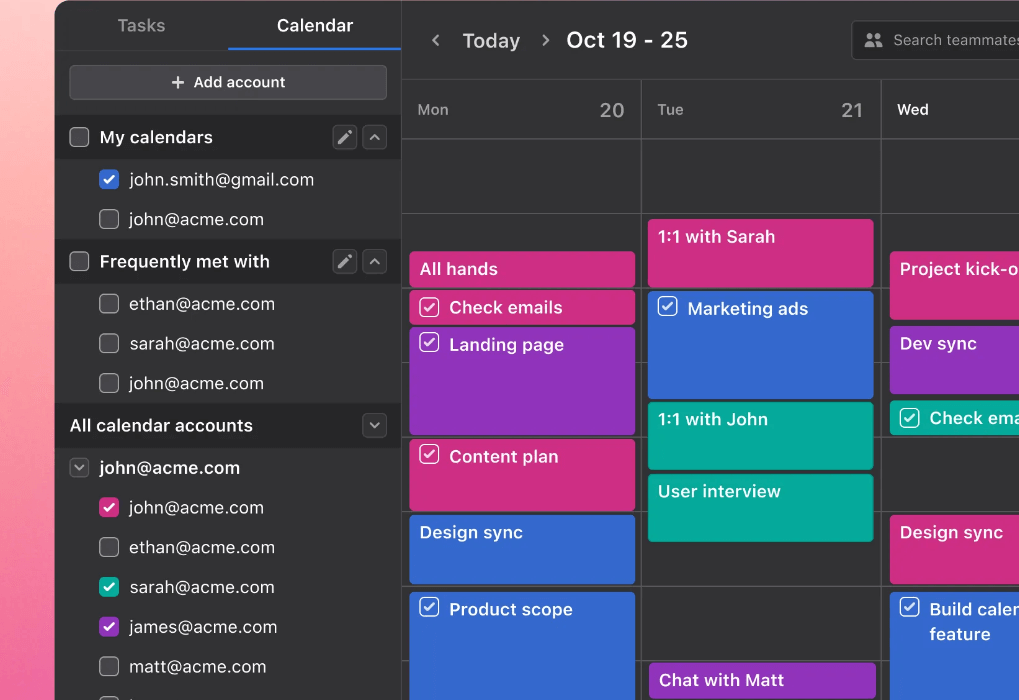 |
Motion is a cloud-based team calendar that's designed to simplify team scheduling and improve collaboration. Motion's key features include a real-time dashboard that provides an overview of team schedules and daily tasks, the ability to create and manage multiple calendars, and customizable views for individual team members.
Motion offers a free 7-day trial to test out the product, after which it’s priced at $34/month for its Individual package, and $20/user for the team package. This makes it an affordable option for businesses of all sizes. One of the major pros of Motion is its intuitive user interface, which makes it easy for team members to use without a steep learning curve.
The customizable views for individual team members are also a significant advantage, allowing each team member to see their schedule in a way that works best for them. It’s cutting-edge algorithmic AI is also efficient at helping team members automatically restructure their calendars based on task priority and deadlines.
However, one of the major cons of Motion is that it offers limited integration with other popular productivity tools when compared to other calendars on this list.
2. Google Calendar - Best for companies that use Google ecosystem
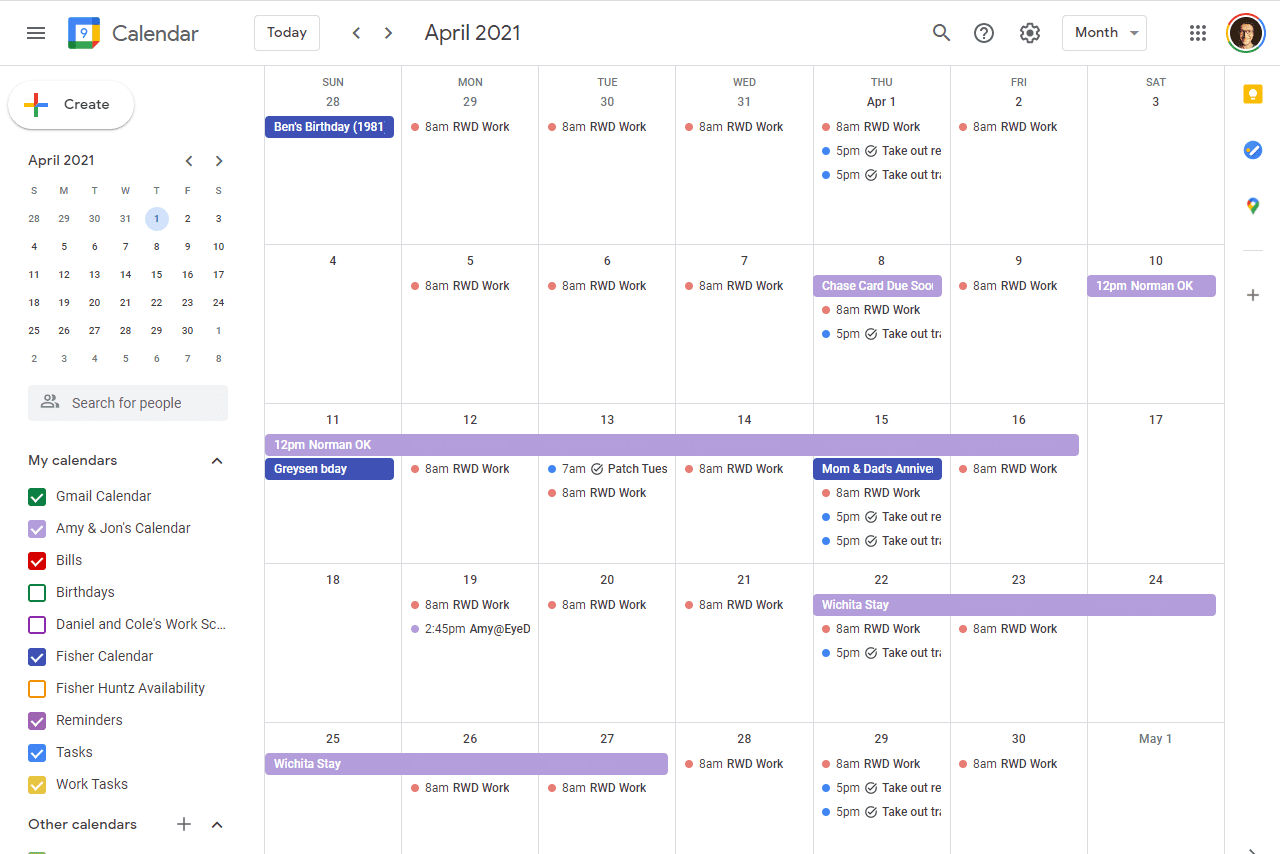 |
Google Calendar is one of the most widely used calendars available on the market today. Its key features include the ability to create and manage multiple professional and personal calendars, integrate with other Google apps, and set up reminders for upcoming events.
Google Calendar’s basic plan is free to use for individuals and small teams, making it an attractive option for businesses on a tight budget. However, for larger teams or organizations, the price can increase anywhere from $6 a month up to $18 per user per month for the complete Google Workspace.
One of the major pros of Google Calendar is its deep integration with other Google apps, making it a seamless experience for users who are already using these tools. Additionally, Google Calendar offers robust mobile apps for both Android and iOS, allowing team members to access their schedules on the go.
However, one of the major cons of Google Calendar is that it can be overwhelming for some users, with too many options and settings to navigate. Additionally, as a collaboration tool, its customization options are somewhat limited compared to other team calendar options on this list.
3. TeamUp - Best for group scheduling
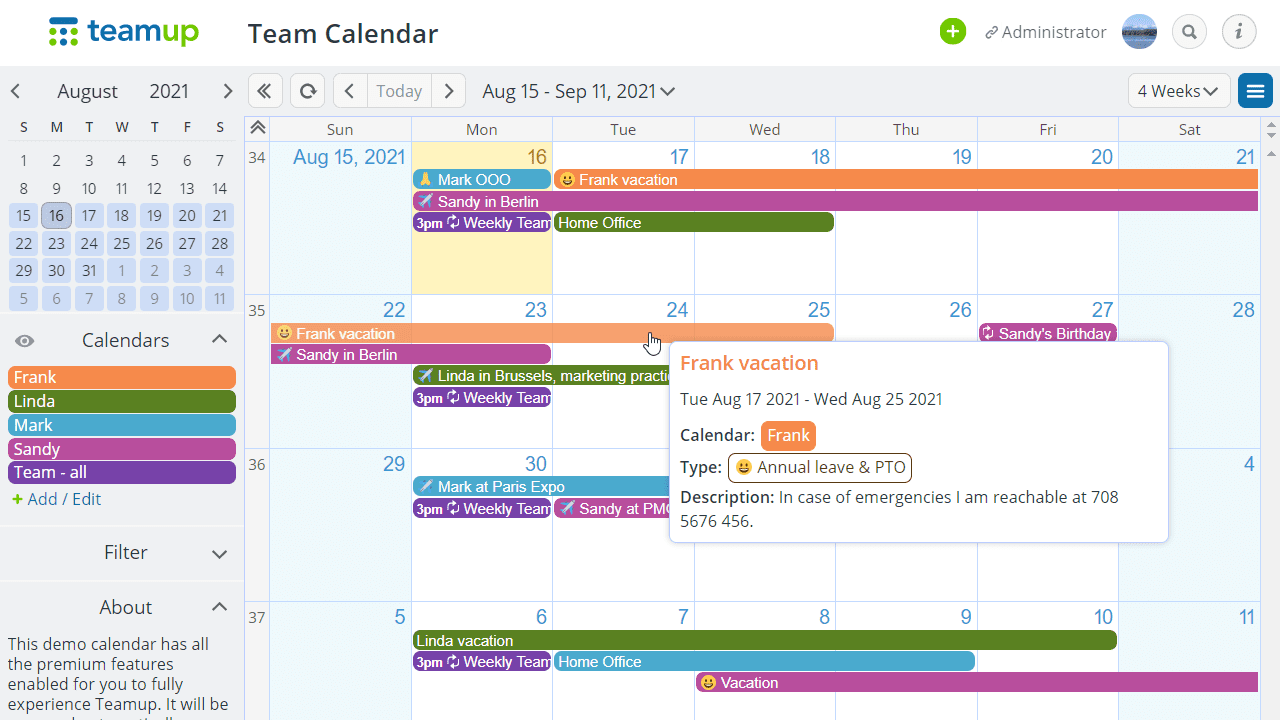 |
TeamUp is a comprehensive team calendar that offers features such as color-coded events, drag-and-drop scheduling, and the ability to assign tasks and events to specific team members. TeamUp's key features include robust filtering options, the ability to customize access levels for team members, and the ability to embed calendars on websites.
TeamUp is priced at $0/month for its free basic plan to $129 per month for an enterprise plan.. One of the major pros of TeamUp is its extensive customization options, including the ability to choose from several color schemes and its calendar functionality.
However, one of the major cons of TeamUp is that it can be somewhat overwhelming for first-time users. Additionally, while it offers integration with several popular productivity tools such as Asana and Trello, these integrations aren't as robust as some of the other options on this list.
4. Asana - Best for task management
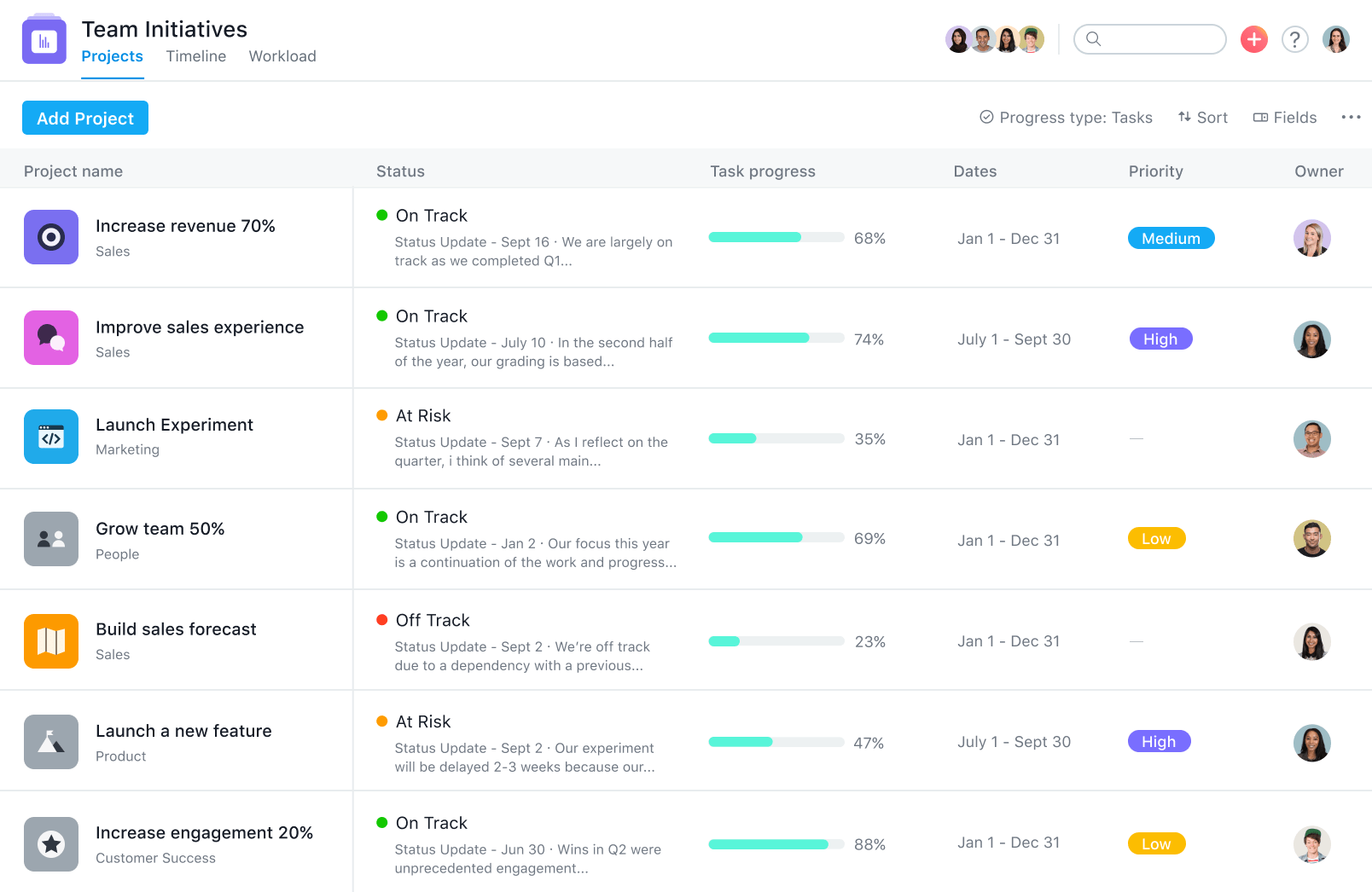 |
Asana is primarily known as a project management app, but it also offers a team calendar feature that's worth considering. Asana's key features include the ability to create and manage multiple calendars, integration with other popular productivity tools, such as Google Drive and Slack, and the ability to customize your calendar.
Asana offers a free plan, a premium plan priced at $13.4 per user per month, and a $30.49 for its Business plan. One of the major pros of Asana is its deep integration with other productivity tools, allowing teams to manage all aspects of their work in one place.
However, one of the major cons of Asana's team calendar feature is that it isn't as robust as some of the other options on this list. For example, it lacks some of the customization options and filtering features that are available in other team calendars. Additionally, Asana's pricing can be expensive for smaller businesses.
5. Calendly - Best for appointment scheduling
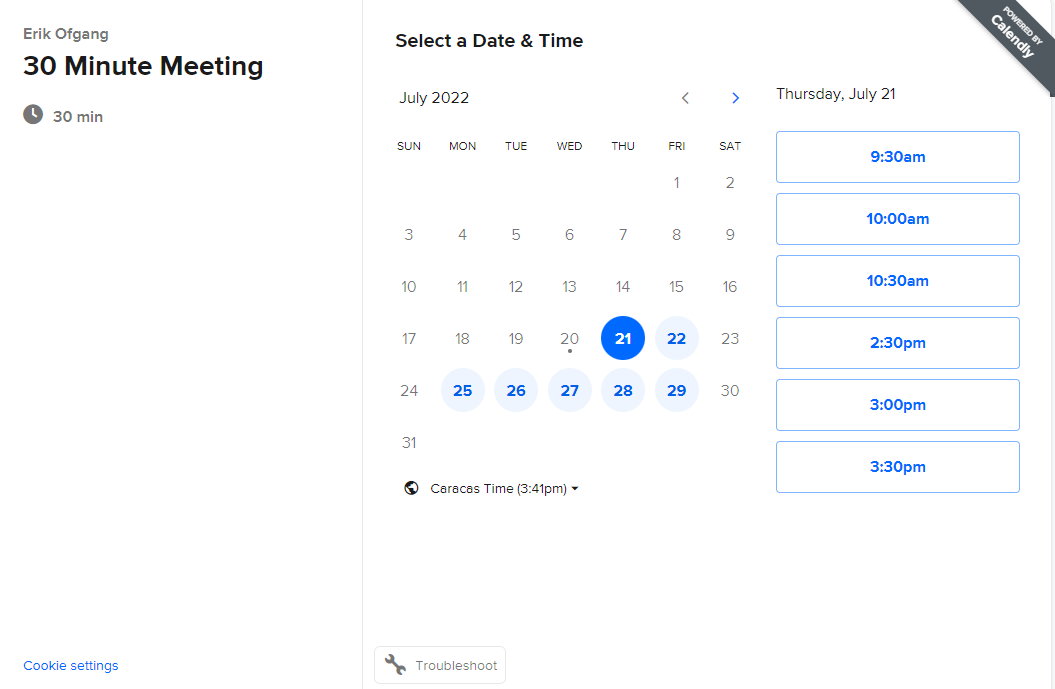 |
Calendly is a team calendar that's primarily focused on scheduling appointments and meetings. Its key features include the ability to customize meeting availability, integration with popular calendar apps such as Google Calendar, and the ability to send automated reminders and follow-ups.
Calendly offers a free plan, an Essential plan priced at $8/user/month, a Professional plan at $12/user/month, a Teams plan at $18/user/month, and a custom Enterprise plan. One of the major pros of Calendly is its ease of use, with a simple and intuitive user interface that makes scheduling meetings and appointments a breeze.
However, one of the major cons of Calendly is that it is primarily designed for booking meetings and appointments, and may not be the best option for businesses that require a more robust team calendar functionality. Additionally, its customization options are somewhat limited compared to other team calendar options on this list.
Conclusion
Team calendars are an essential tool for improving communication, collaboration, and productivity within a team. By providing a single centralized platform for scheduling and managing tasks, team calendars help improve coordination, transparency, and productivity.
There are many factors to consider before selecting the right team calendar for your business, such as user-friendliness, cost, features, accessibility, and security.
Motion is particularly useful, as its algorithmic AI helps you automatically reorganize your calendar based on priority. It also allows you to combine all your calendars, both personal and professional, into a single calendar, helping you structure your life better.
For a free 7-day free trial of Motion, click here.





